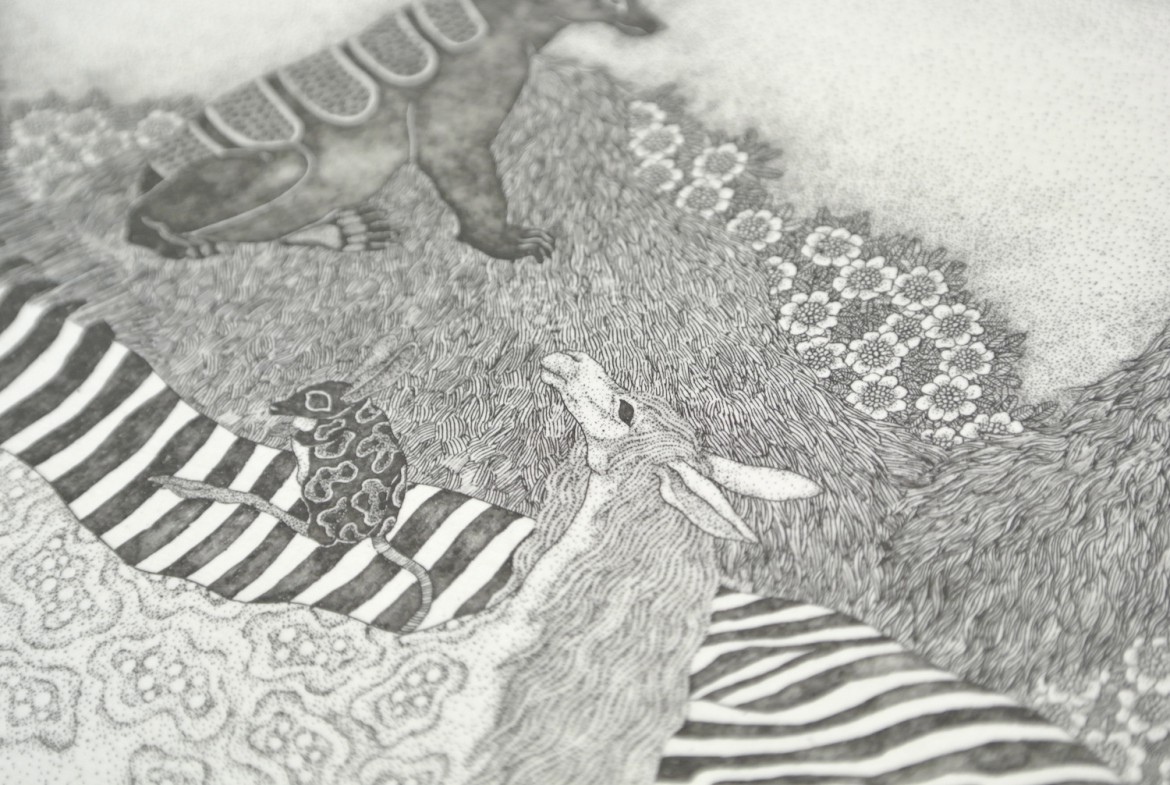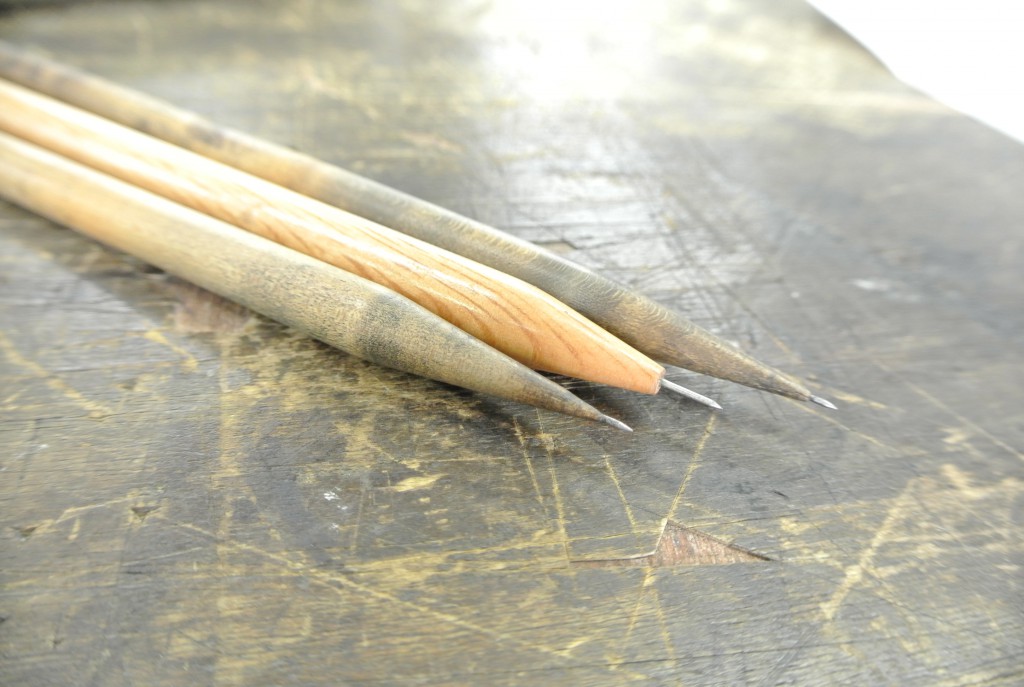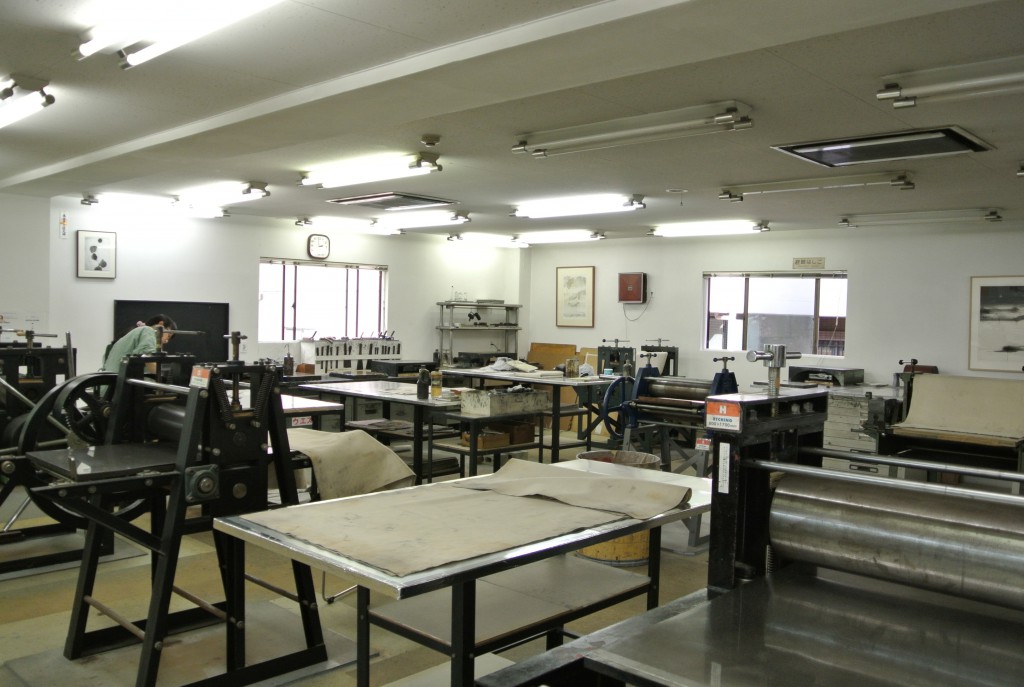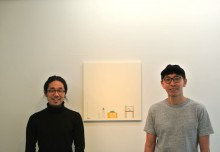Detail of the etching work by Etsuko Fukaya
Etsuko Fukaya creates a world of animals and plants condensed in a small piece of work. Surprisingly, some pieces include more than 80 animals within a small frame. To accomplish this highly dense expression, she chose etching as a method and uses thin needles to sensitively scratch lines and point dots on a copperplate. Every single hair or complicated patterns of skin are all drawn by her hand without a magnifier. Although it sounds like an enormous amount of work, she actually enjoys this process. We interviewed her at her printing studio. She talked how this intricate expression was born.
Fill in the frame with animals and plants like puzzle pieces
-How do you create your work?
I do a lot of drawings in my sketchbook and decide the entire image. My first drawings are not done precisely so it is different from a typical draft drawing. I don’t think about any concepts while I am drawing.
After roughly drawing the whole composition, I start to fill in the details.
-So you decide the composition first in your drawings.
Right. And then, I allocate an animal matches to a shape in the drawing. I draw on more than a hundred papers to decide the final image of a work.
-Oh, that’s a lot. How do you get your ideas? Is it from your daily life?
No, not like that. I usually do drawings without any thoughts. Sometimes, I feel specifically that I want to draw a lion, corresponded to what I was thinking at that moment. But that is rare.

Etching print by Etsuko Fukaya
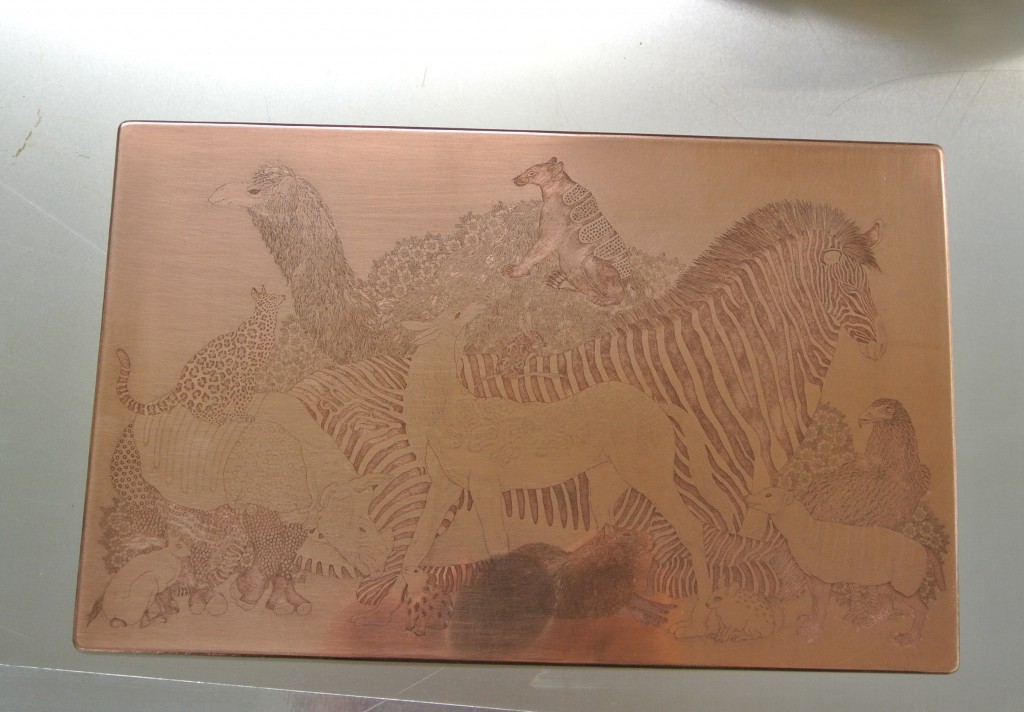
Copper plate of Estuko Fukaya’s etching work
Imaginative animals were born by combining different patterns
-Do you see pictorial books?
Yes, I do. I see a lot. I have many of them. Since I put too many tags on pages (for reference), they have no meaning now. (laughs)
Sometimes, I’m surprised to see the real size of fish that I had seen in a pictorial book. Of course, the sized is written although it’s hard to imagine the actual size. Seeing it moving also gives me different impressions as well.
- Some of the animals you draw are not real ones. How do these imaginative animals come out?
Sometimes, I allocate an animal which has similar shape within the drawing, and then add different patterns.
-How do you decide the patterns?
It comes up when I am drawing. Some animals are prioritized than others and decided first. When I get stacked, I use polka dots! Or think about them later.
-Now, I’ve noticed that the patterns of the animals next each other are different!
Right, otherwise boundaries of animals will get blur.
This zebra supposed to be a horse with a harness in the beginning and another animal was planned to be drawn with stripes. However, when I changed my mind to draw the horse as a zebra, I changed the other animal that supposed to be in stripes.
- When did you find your interest in patterns?
When I was a college student, my teacher told me that patterns in my work is interesting. That was my first chance to think about it deeply. I hadn’t thought about it that much before.
It is natural to adapt animal patterns in animals. It becomes unnatural if I adapt artificial objects’.
-How about the posing?
Sometimes I draw exactly as it was drawn in the pictorial book. For imaginative animals, I try to draw it as consistent as an animal. To Make it more like a real one.
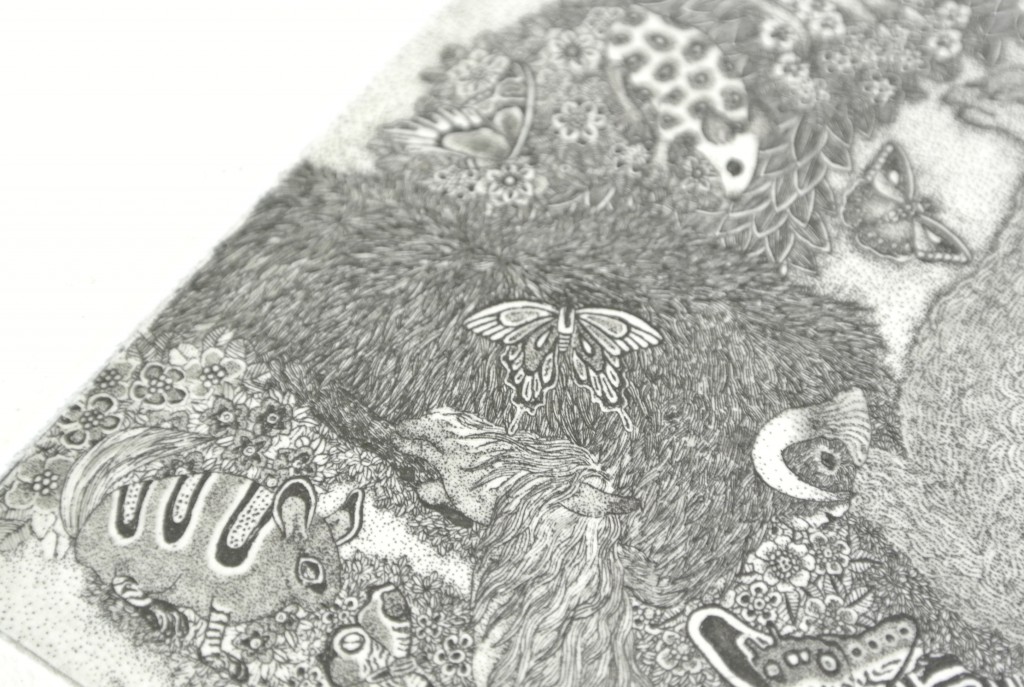
Details of Etsuko Fukaya’s etching work.
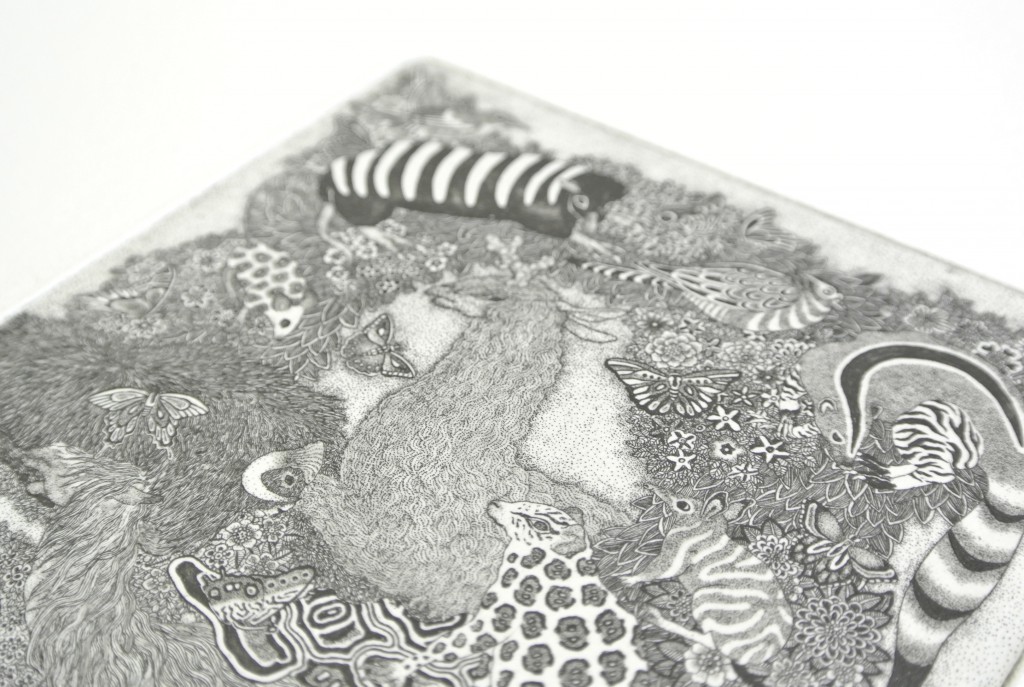
Etching by Etsuko Fukaya
Natural objects hold a sense of closeness
- You only choose animals or plants for the?motifs.
I wasn’t good at drawing artificial objects. There was an assignment to draw a scrambled paper in cram school since it is cheap and creates dark and light. Aluminum foils were also chosen as an assignment to draw. I remember that I felt like, “Drawing paper again?!”or “I don’t wanna draw?aluminum foils any more.” I didn’t like it… Eggs are better, apples are much better. Natural objects have uniqueness and personality. I can feel closer to those objects. I couldn’t feel close to a piece of paper…
When the object is the only one existence on the earth, I have?strong enthusiasm for?drawing it. Not cups. Nature is the best! I want to draw as it is. Rum blossoms are excellent motif.
-How about humans?
I don’t draw human so much, but after seeing Makoto Aida’s exhibition (at mori museum, 2012), it made me feel that I have to draw. It could be unnatural avoid drawing it. However, drawing humans has too many elements to decide. Whether it should be a man or woman, what to wear, what kind of nose, face…. It bothers me… Should I draw it realistically or more like a cartoon? Should it be facing front or side? It should be a beauty… Something like that.
To draw an animal, I just have to match it up to its shape. But human doesn’t work like that. Viewer reads human’s face unconsciously. It’s inevitable. There are too much elements to decide. Also including even one human being will show?a big presence in my work.
- Right, there aren’t much to read from animals’ faces or posing.
We don’t care how old the animal is, whether it is feeling hungry or not. I can’t work on drawing a human without overcoming this problem.
Grown up in a rural area surrounded by nature.
- What was your childhood like?
I loved drawing but didn’t do sketching. I drew girls or manga-like drawings. I thought that I want to draw better technically then I decide to enter an art college. That was the beginning.
- When did you decide to become an artist?
I wanted to be an artist since I was little. Although I knew that it is difficult in some ways and thought to become something else. However, when I encountered etching, I thought that I can do it for my entire life. So I decided to pursue to my first dream.
- You first majored oil painting but changed to etching.
Yes, we couldn’t major etching in the beginning of our college. When I use a paint brush, it runs too smoothly and won’t allow me to draw narrow lines as I expected. Etching lets me express as I want to. That’s the main reason of why I chose etching.
-How about the technique of drawing motifs precisely?
It’s after I learned sketching. I love plants. It was my father’s influence. He loved gardening. My grandmother also had a grain field. I live in a rural area surrounded by nature. There was an ocean near by, mountains were close. I went to a sandy beach to look for shells just like a usual kid. Played with tetrapods, picked up acorns near by my house and drew it on a paper. My grandmother ran a stationary shop and there were many pencils and drawing materials.
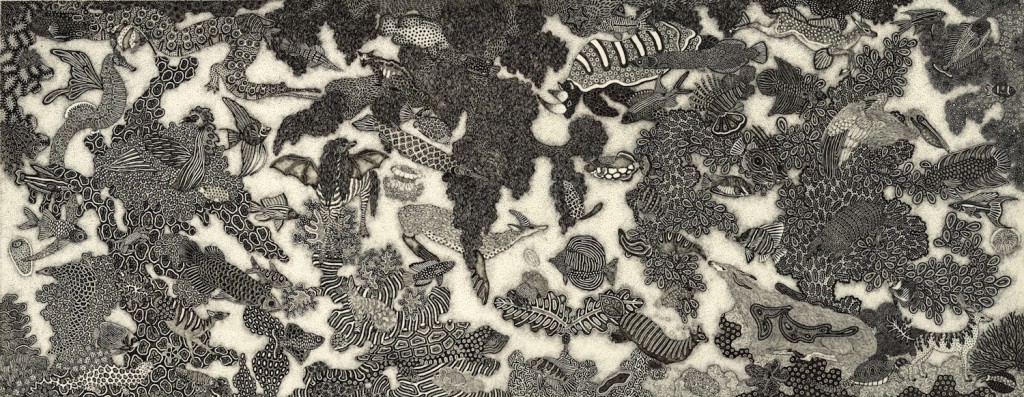
Etsuko Fukaya “Untitled (25)”
Patterns we can imagine already exist in nature
- Have you done scuba diving? When I dove I felt like being a guest of fish world. I am the stranger. Your work reminded me of that sense.
I am glad to hear that! I am thinking of it when I create a work. No, I haven’t done diving yet but would like to whenever I have any chances. I haven’t been to southern islands and those are unknown world for me.
-I am always surprised to find unique animal’s patters in a zoo.
Most of the pattern that we can imagine already exists in the world. That’s an exciting part of nature. Knowing that makes me feel relieved. Nature is more greater than my imagination. I feel relieved to know the greatness of animals. I can draw without anxiety by knowing that.
-Actual animals have unique colors. How do you transfer it into black and white expression?
I imaging how this coloration could be expressed in black and white. However, sometimes I feel I want to use colors, hahaha.
-Since you don’t use colors, viewers can concentrate on the shapes and patterns. Are there any animals which you don’t draw?
I don’t draw insects. I can even stand seeing them in a pictorial book. Those are awful… Since my home had a garden, there were many bugs on leaves. I’m okay with them but don’t like them. Especially in a pictorial book, insects are drawn in a bigger scale. It’s ugly… Not cute at all. Reptiles are okay. I love their skins.
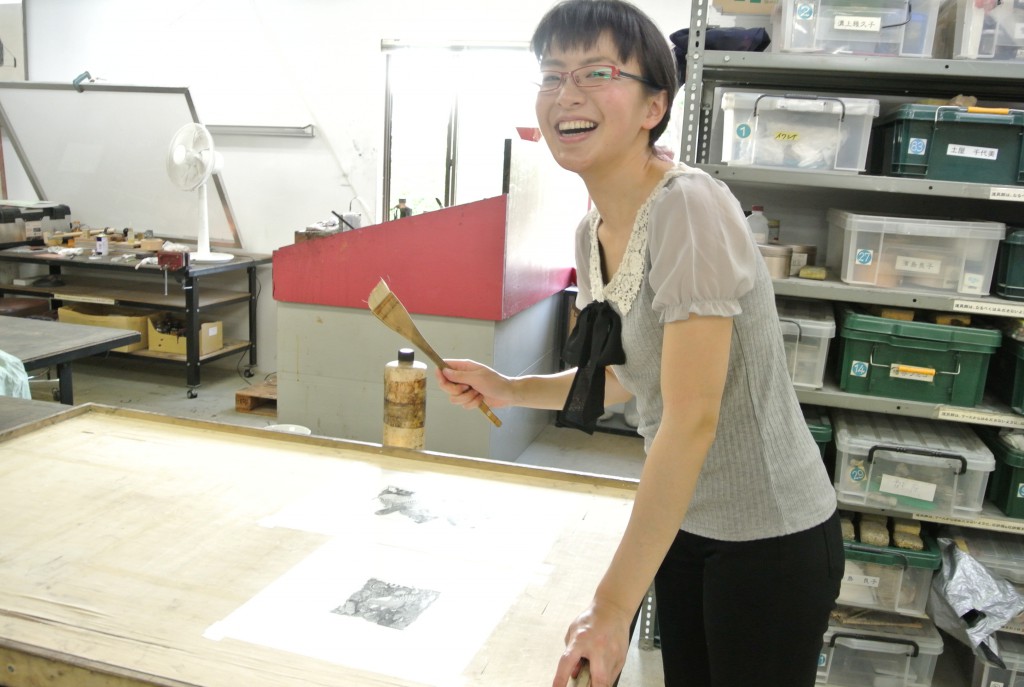
Etsuko Fukaya at her studio

Detail of Etsuko Fukaya “Untitled (10)”
-Wow, this animal is all drawn with dots!
Following my interest, I tried drawing with dots. However, I found that drawing with dots ends up with fewer failures. Lines are difficult print as I imagined.
-It is amazing that you draw every single furs!
That’s the fun part.
Interviewed on May 23, 2013 and April 24 2015 by Rasa Tsuda


